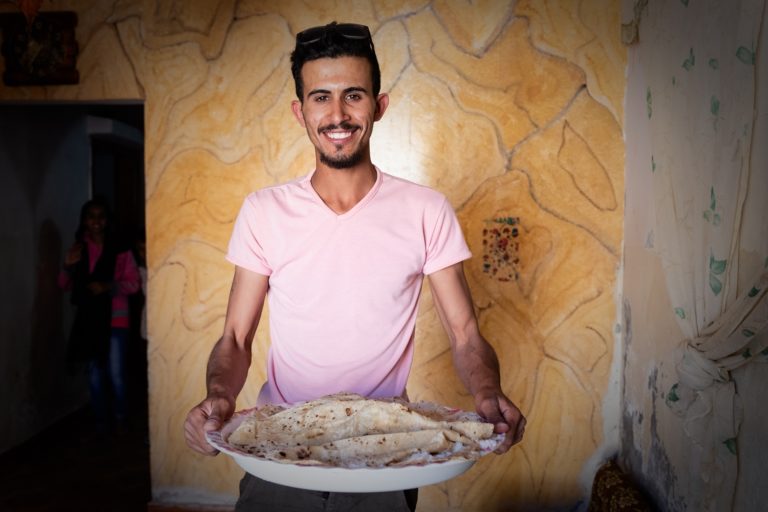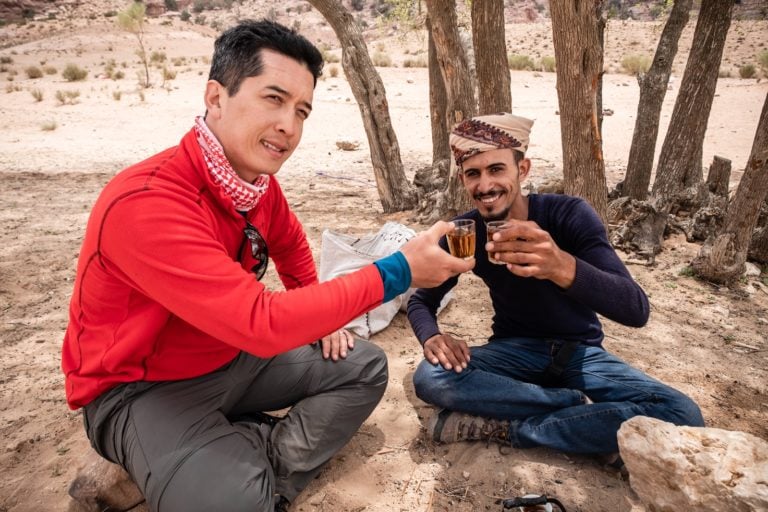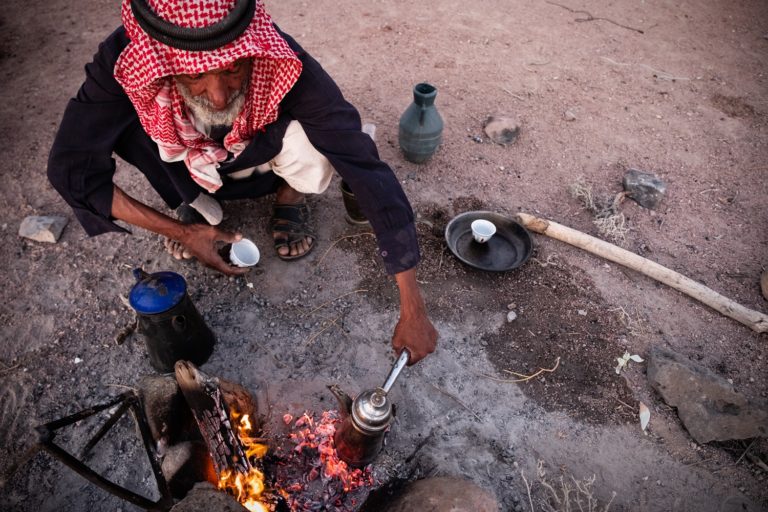A Culinary Adventure in Jordan: Dishes Not To Miss
With a diverse history and a vibrant culture, food in Jordan draws from many traditions and groups that existed in the region over thousands of years. Food is at the heart of Jordanian culture. A highlight of any trip to Jordan is exploring the food. Below are some dishes to dive into on your next trip to this country.
Mansaf
One of Jordan’s most beloved dishes, Mansaf is good home cooking – whether it is served when you visit friends, the house specialty at a restaurant, the main dish at a special ceremony or at a wedding. It is widely considered the national dish of Jordan. When our friend Ali got married the special dished cooked just for the wedding was Mansaf (with a goat yogurt sauce, it was incredible). Mansaf consists of three main ingredients – lamb (sometimes chicken is used instead of lamb), rice and jameed. Jameed is a fermented goats milk yogurt which is poured over the rice and meat. This a tasty, savory dish that has its origins in Jordan’s Bedouin heritage.
Where to eat Mansaf: Mansaf is best eaten in a home or at a local gathering/special occasional. This will be the good homecooked variety. In Amman, you can try Mansaf at Tawa Al Hawa Restaurant or Sufra Restaurant sometimes has it on the menu.

Falafel & Hummus at Hashem’s
Are all falafel and hummus the same? How is this uniquely Jordanian? Well there is falafel and hummus and then there’s Falafel and Hummus at Hashem’s. An institution, Hashem’s makes 3 dishes and only 3 dishes – falafel, hummus and moutabel. Falafel is made of ground chickpeas and local spices, which is deep fried into round patties. It’s a dish that is synonymous with the Middle East, but Hashem’s Restaurant takes it to a whole new level. Everyone from the local shopkeeper to the King of Jordan eats here.
Where to eat Falafel & Hummus: Visit Hashem’s Restaurant in Amman for the best hummus and falafel in the Middle East.
Moutabel
A dish made from eggplant and yogurt, Moutabel is popular in Jordan and is usually served alongside hummus and falafel. It’s a creamy, smooth dip that is a mix of roasted eggplant, yogurt, tahini, lemon juice and garlic.
Where to eat Moutabel: You can also dine on excellent Moutabel at Hashem’ Restaurant.

Maqluba
Maqluba is a dish of lamb or chicken mixed with rice and Jordanian spices. It is cooked in a large pot with the rice on top and meat underneath. When Maqluba is served the pot is flipped upside down so the rice is on bottom of the plate and chicken or lamb on top. It is often cooked in the home at special family gatherings and events. The name Maqluba literally means “upside down.”
Where to eat Maqluba: Enjoy Maqluba while visiting a family in Jordan or at Tawaheen Al Hawa in Amman.
Warak Enab and Kousa Mahshi:
Jordan has a number of stuffed veggie dishes. Warak Enab is grape leaves stuffed with rice, ground meat, spices and onions. While Kousa Mahshi is zucchini is stuffed with a similar mix of ground meat, rice, onions and spices. The veggies are first prepared and then slowly cooked in the oven. These dishes are often part of a large mezze spread.
Where to eat Warak Enab and Kousa Mahsi: Sufra Restaurant in Amman serves both Warak Enab and Kousa Mahshi.
Zarb
Zarb is a traditional Bedouin dish, which is under the ground. In a large pot is placed a mix of different meat, rice, vegetables and spice. The pot is placed on coals in the a hole in the ground and that hole is covered with dirt or sand. The pot is left to slow cook.
Where to eat Zarb: Zarb is best enjoyed in Wadi Rum at one of the Bedouin-run desert camps.
Manakish
Cousin to the pizza, Manakish is a round flat bread topped with za’atar (thyme and seasoning), olive oil, and sometimes white cheese, eggs or ground meat. This dish is popular in Jordan.
Where to eat Manakish: Bait Al Manakish, Lebanese Pastries and Crumz Bakeries are all popular places to dine on Manakish.
Mujadara
Mujadara is a dish made up of rice, lentils and cumin topped with carmelized onions and pine nuts. Another common Jordanian meal to cook at home, it is becoming more common as a quick bit to eat in many restaurants and cafes in Amman.
Where to eat Mujadara: Enjoy Mujadara at Kan Zaman in Amman.

Kibbeh
Often included in a mezze spread or served as a light meal, Kibbeh are small, deep friend balls of bulgar wheat stuffed with minced meat, onions and spices.
Where to eat Kibbeh: Most restaurants in Amman will serve Kibbeh as an appetizer.
Hareesh
Hareesh is a Jordanian dessert made of coconut, semolina, cream, yogurt, and almonds. The items are mixed together into a batter and then baked until golden brown.
Where to eat Hareesh: Most bakeries in Amman serve Hareesh. Salaheddin Bakery is famous for this tasty desert.
Bread
Bread is an important staple of any Jordanian meal. In Jordan, it’s not a meal if there isn’t bread.
Bedouin Tea
Tea is an important part of daily life in Jordan. It is served at meals (breakfast, lunch and dinner), brought out when guests arrive at home, the first thing you do when checking into a hotel and pretty much an hourly requirement on road trips. All the best conversations and moments in Jordan happen over a piping hot brew of tea. Often served with sage or mint and a few heaping spoonfuls of sugar, the secret ingredient in Jordanian tea is the strong green tea leaves they add.
Where to try Jordanian tea: The answer is everywhere! A must experience though is sipping a pipping cup of this strong tea next to a roaring fire in the expansive Wadi Rum desert with a swarth of a million twinkling stars overhead.

Coffee
Arabic-style coffee is an important part of Bedouin customs, just like tea. And today, this style of coffee can be found throughout Jordan, usually served in restaurants after meals. Bedouin culture is integral to Jordanian society and considered a national treasure. In Bedouin culture, the coffee ceremony is performed for guests and at special ceremonies. It involves making the stiff dark coffee over a fire and offering 3 cups of coffee to your guest. The best way to parttake in these special coffee ceremonies is to arrange a visit to a Bedouin family along the Jordan trail.





